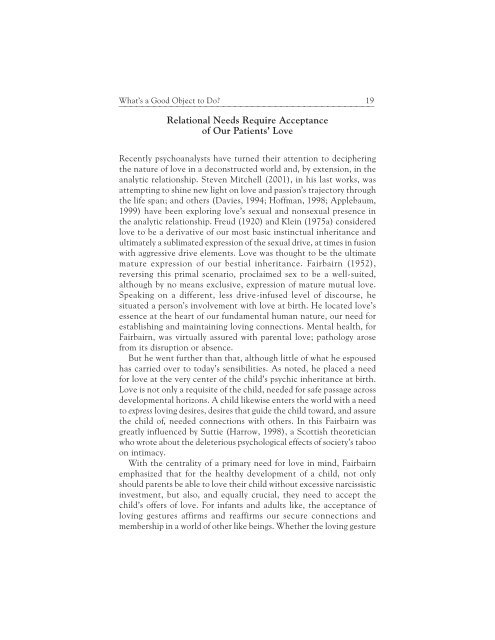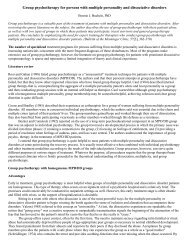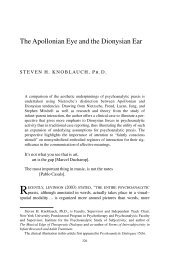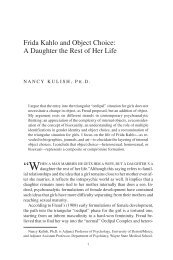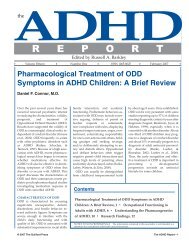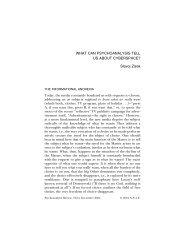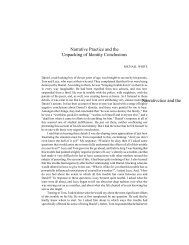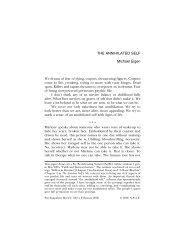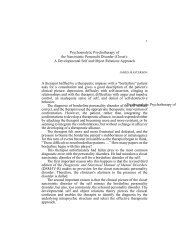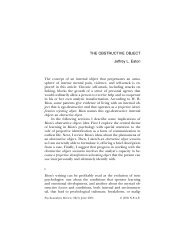What's a Good Object to Do? - PsyBC
What's a Good Object to Do? - PsyBC
What's a Good Object to Do? - PsyBC
You also want an ePaper? Increase the reach of your titles
YUMPU automatically turns print PDFs into web optimized ePapers that Google loves.
What’s a <strong>Good</strong> <strong>Object</strong> <strong>to</strong> <strong>Do</strong> 19<br />
⎯⎯⎯⎯⎯⎯⎯⎯⎯⎯⎯⎯⎯⎯⎯⎯⎯⎯⎯⎯⎯⎯⎯⎯⎯⎯⎯⎯⎯⎯⎯⎯⎯⎯⎯⎯⎯⎯⎯⎯⎯⎯⎯⎯<br />
Relational Needs Require Acceptance<br />
of Our Patients’ Love<br />
Recently psychoanalysts have turned their attention <strong>to</strong> deciphering<br />
the nature of love in a deconstructed world and, by extension, in the<br />
analytic relationship. Steven Mitchell (2001), in his last works, was<br />
attempting <strong>to</strong> shine new light on love and passion’s trajec<strong>to</strong>ry through<br />
the life span; and others (Davies, 1994; Hoffman, 1998; Applebaum,<br />
1999) have been exploring love’s sexual and nonsexual presence in<br />
the analytic relationship. Freud (1920) and Klein (1975a) considered<br />
love <strong>to</strong> be a derivative of our most basic instinctual inheritance and<br />
ultimately a sublimated expression of the sexual drive, at times in fusion<br />
with aggressive drive elements. Love was thought <strong>to</strong> be the ultimate<br />
mature expression of our bestial inheritance. Fairbairn (1952),<br />
reversing this primal scenario, proclaimed sex <strong>to</strong> be a well-suited,<br />
although by no means exclusive, expression of mature mutual love.<br />
Speaking on a different, less drive-infused level of discourse, he<br />
situated a person’s involvement with love at birth. He located love’s<br />
essence at the heart of our fundamental human nature, our need for<br />
establishing and maintaining loving connections. Mental health, for<br />
Fairbairn, was virtually assured with parental love; pathology arose<br />
from its disruption or absence.<br />
But he went further than that, although little of what he espoused<br />
has carried over <strong>to</strong> <strong>to</strong>day’s sensibilities. As noted, he placed a need<br />
for love at the very center of the child’s psychic inheritance at birth.<br />
Love is not only a requisite of the child, needed for safe passage across<br />
developmental horizons. A child likewise enters the world with a need<br />
<strong>to</strong> express loving desires, desires that guide the child <strong>to</strong>ward, and assure<br />
the child of, needed connections with others. In this Fairbairn was<br />
greatly influenced by Suttie (Harrow, 1998), a Scottish theoretician<br />
who wrote about the deleterious psychological effects of society’s taboo<br />
on intimacy.<br />
With the centrality of a primary need for love in mind, Fairbairn<br />
emphasized that for the healthy development of a child, not only<br />
should parents be able <strong>to</strong> love their child without excessive narcissistic<br />
investment, but also, and equally crucial, they need <strong>to</strong> accept the<br />
child’s offers of love. For infants and adults like, the acceptance of<br />
loving gestures affirms and reaffirms our secure connections and<br />
membership in a world of other like beings. Whether the loving gesture


